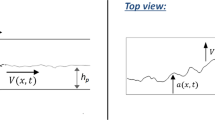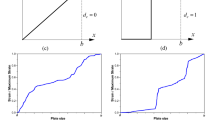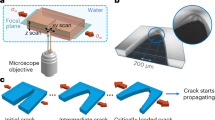Abstract
Interest is growing in the wide variety of fractal objects1 found in nature; these include electric discharge patterns2, infinite percolation clusters3,4, branched polymers5,6 and surface irregularities7. The question of whether surface cracks, such as those that occur in protective coatings, also lead to fractal-like structures is another problem of great interest. Here we study this question theoretically, making use of a molecular model for material failure, introduced previously8, which is based on the kinetic theory of fracture9,10. The model is applied to a two-dimensional surface stretched in one direction, and our results show that the cracks developing in the material exhibit properties similar to each other, at least at the molecular level. For a wide range of values of the elastic constants of the material, the fractal dimensionality is found to have a universal value, D = 1.27 ± 0.02.
This is a preview of subscription content, access via your institution
Access options
Subscribe to this journal
Receive 51 print issues and online access
$199.00 per year
only $3.90 per issue
Buy this article
- Purchase on Springer Link
- Instant access to full article PDF
Prices may be subject to local taxes which are calculated during checkout
Similar content being viewed by others
References
Mandelbrot, B. B. The Fractal Geometry of Nature, 1–468 (Freeman, San Francisco, 1982).
Niemeyer, L., Pietronero, L. & Wiesman, H. J. Phys. Rev. Lett. 52, 1033–1036 (1984).
Stanley, H. E. J. Phys. A10, L211–L220 (1977).
Kapitulnik, A., Aharony, A., Deutscher, G. & Stauffer, D. J. Phys. A16, L269–L274 (1983).
Family, F. Phys. Rev. Lett. 51, 2112–2115 (1983).
Termonia, Y. & Meakin, P. Phys. Rev. Lett. 54, 1083–1086 (1985).
Avnir, D., Farin, D. & Pfeifer, P. Nature 308, 261–263 (1984).
Termonia, Y., Meakin, P. & Smith, P. Macromolecules 18, 2246–2252 (1985).
Kausch, H. H. Polymer Fracture, 1–332 (Springer, Berlin, 1978).
Dobrodumov, A. V. & El'yashevitch, A. M. Sov. Phys. Solid State 15, 1259–1260 (1973).
de G. Allen, D. N. Relaxation Methods, 1–230 (McGraw-Hill, New York, 1954).
Farin, D., Peleg, S., Yavin, D. & Avnir, D. preprint, Hebrew Univ. of Jerusalem (1985).
Voss, R. F. J. Phys. A17, L373–L377 (1984).
Avnir, D. & Farin, D. J. chem. Phys. 79, 3566–3571 (1983).
Mandelbrot, B. B., Passoja, D. E. & Paullay, A. J. Nature 308, 721–722 (1984).
Author information
Authors and Affiliations
Rights and permissions
About this article
Cite this article
Termonia, Y., Meakin, P. Formation of fractal cracks in a kinetic fracture model. Nature 320, 429–431 (1986). https://doi.org/10.1038/320429a0
Received:
Accepted:
Issue Date:
DOI: https://doi.org/10.1038/320429a0
This article is cited by
-
A solution to the parameter-identification conundrum: multi-scale interaction potentials
International Journal of Fracture (2013)
-
Impact damage patterns studied by a model simulation
Journal of Materials Science (1996)
-
Towards a new view of earthquake phenomena
Pure and Applied Geophysics PAGEOPH (1992)
-
Fractured but not fractal: Fragmentation of the gulf of suez basement
Pure and Applied Geophysics PAGEOPH (1989)
Comments
By submitting a comment you agree to abide by our Terms and Community Guidelines. If you find something abusive or that does not comply with our terms or guidelines please flag it as inappropriate.



